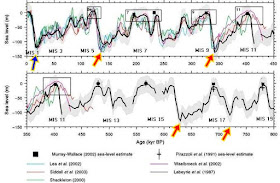This paper
Middle Stone Age human teeth from Magubike rockshelter,
Iringa Region, Tanzania, by Pamela R. Willoughby, Tim Compton, Silvia M. Bello, Pastory M. Bushozi, Anne R. Skinner and Chris B. Stringer. Published: July 31, 2018https://doi.org/10.1371/journal.pone.0200530, discusses human teeth found in Africa:
They are significant because they come from Tanzania (the Magubike rockshelter) and are apparently fom Middle Stone Age (MSA) deposits dated and a
"conservative estimate of their minimum age is 45,000 years" according to the paper.
As we all know, finding human remains in this part of Africa, especially those from the Middle Stone Age (which took place between 320,000 and 30,000 years ago) is a very rare event.
The authors try to find similarities between these ancient teeth and the San people (the San are always mentioned because they are assumed to be a "relict" of
the original Homo sapiens that left Africa, the "oldest" extant humans, the "most diversified" members of our species.
And they say so, albeit cautiously, in this paper: "... a number of characteristics in the Magubike teeth suggest possible San affinities.".
But as we go into the details, it seems that these teeth are indeed quite unique, and, in my opinion, not at all like those of the San people:
Quoting the authors: (bold is mine)
"In summary, the Magubike teeth have the characteristics typical of African sub-Saharan Homo sapiens Holocene teeth, but aspects of the morphology of the
upper canine and third premolar are atypical for the African mid/late Pleistocene sample.
However, this may be at least partly due to its North African bias.
Certain traits present ― e.g. the root shape of the lateral incisor and canine, and the presence of a cingulum pit on the lateral incisor ―
are rare or absent in the comparative samples. Traits specific to Homo heidelbergensis / archaic Homo sapiens and Aterian teeth are not present.
Despite their large size, there is some suggestion of San affinities, though this interpretation must be very tentative, being based on a single individual."
The interesting part is the similarity with Neanderthal and Homo erectus features: (again bold is mine)
"... The pronounced buccal vertical curvature of the canine root found at Magubike is seen in early teeth, Homo erectus and Neanderthal [22, 47], but not in samples of early modern Homo sapiens (Skhūl and Qafzeh) or European Upper Palaeolithic Homo sapiens[48].
In recent teeth, the buccal surface is usually straight or has a mild curvature [49]. The few canine roots that could be observed in the Kenyan early Holocene sample, and the two in the Gwisho sample, are straight, and in the mid/late Pleistocene sample only the Broken Hill canine has similar curvature to that of the Magubike canine."
In other words it is not found among early modern Homo sapiens, only in Neanderthals and H. erectus. The authors continue, finding some examples of curvature in recent African samples (7% of them - a low figure) which may have come from out of African migrants in more recent times...:
"However, four instances were found in the recent sub-Saharan East/South African sample (7%). Similarly, the incomplete root of the Magubike lateral incisor
has pronounced buccal vertical curvature in contrast to the more evenly tapered form of recent teeth [50]. A lateral incisor of this form occurs at the Klasies River Main site [51] and in one of four in the Gwisho sample, but in just one out of seventy-five in the recent East/South African sample."
As we see in the preceden paragraph, there are yet more morphological traits that are not at all related to modern African samples.
And the authors admit the teeth's unusual uniqueness very clearly:
"The six Magubike teeth are differentiated from African archaic Homo sapiens / Homo heidelbergensis and Aterian teeth in terms of size and the lack of
morphological traits that could be associated with these groups. They are also differentiated from the Kenyan early Holocene and Gwisho samples
and more recent teeth in terms of the relative size of the incisors, the incisor crown heights, the relative crown heights of the two premolars,
and the long premolar roots. However, the morphological evidence is contradictory, principally in relation to the canine having traits that are rare or absent
in the African mid/late Pleistocene sample, though this may be partly due to the small size of this sample and its North African bias."
They attribute this to the small sample size and its "North African bias"
But why try to find them similar to San teeth? Well, orthodoxy requires it: oldest African remains of a Homo sapiens and "oldest" extant humans (SAN) "must" be related:
"Small bodied individuals recovered from East African LSA sites have often been described as having “Khoisanoid affinities”, implying an assumed connection with the small bodied people of South Africa, including the San [75]. There are also still people in northern Tanzania today whose languages are often related to Khoisan (the Hadzabe and Sandawe), implying some possible past connections with southern African peoples [78]."
But what if... the teeth resemble Homo erectus and Neanderthal teeth because these migrated INTO AFRICA? As we can see they don't resemble the African teeth of that time or those of early Modern Homo Sapiens...
Patagonian Monsters -
Cryptozoology, Myths & legends in Patagonia
Copyright 2009-2018 by Austin Whittall ©
